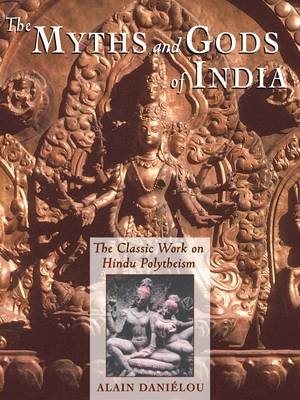
The Myths and Gods of India
Inner Traditions Bear and Company (Verlag)
978-0-89281-354-4 (ISBN)
The study of Hindu mythology explores the significance of the most prominent Hindu dieties as they are envisioned by the Hindus themselves. Referred to by its adherents as the ""eternal religion,"" Hinduism recognizes for each age and each country a new form of revelation--and for each person, according to his or her stage of development, a different path of realization.
Alain Daniélou was an intimate of Stravinsky, Cocteau, and Nabokov in his early years, then spent twenty years in India studying music and philosophy with eminent scholars of the Hindu tradition. He is the author of more than thirty books on the religion, history, and arts of India and the Mediterranean, including While the Gods Play, Gods of Love and Ecstasy, Yoga: Mastering the Secrets of Matter and the Universe, and The Complete Kama Sutra. Daniélou was the founder and director of the International Institute for Comparative Musicology in Berlin, and was a Chevalier de la Legion d’Honneur, Chevalier des Arts et des Lettres, and Officier du Mérite National.
Foreword
List of Illustrations
Note on Translation of the Sanskrit
Note on Pronunciation
ONE: Philosophy
1. The Theory of Polytheism
The Language of Symbols; The Representation of the Transcendent; The Nondual Principle 6 Monotheism and Polytheism; Nondualism and Monism; The Equivalence of Religions
2. The Nature of the Ultimate
The Origin of Existence;The Perceptible Continua: Space, Time, and Thought;The Three Modes of Being: The Substrata of Space, Time, and Consciousness; The" r and the Self; The Realization of the Soul; Immensity (brahman), the Common Substratum; The Three Fundamental Qualities and the Trinity; The Three States of Experience; The Three Qualities and Manifestation; The Power-of-Illusion (maya); Illusion and Ignorance; Nature; The Living Individuality as the Power That Can Oppose Nature; The Power of Nature as the Obstacle to Knowledge; The Fundamental Duality; "God" (Isvara) and the Illusion of Divine Unity; Life as the One Deity; The Relationship of "God" and the Universe; The Causal Word; Dangers of Applied Metaphysics
3. The Cosmic Being
Macrocosm and Microcosm; Cosmic Duration; Cosmic Location; The Nature of Manifestation; The Appearance of the Universe; Cosmic Consciousness; The Personification and the Description of the Cosmic Being
TWO: The Gods of the Vedas
4. The Cosmic Sacrifice
Fire and Offering, Agni and Soma; The Relation of the Spheres; The Ritual of Sacrifice (yajna); The Forms of the Sacrifice; The Technique of the Sacrifice; The Creation of Man; The Last Sacrifice; The Way of the Gods; The Way of the Fathers; Divinity as the Embodiment of the Sacrifice; The Image of the Sacrifice; The Inner Yajna of the Yogi
5. The Thirty-Three Gods
The Three Spheres of Agni; The Three Aspects of Deities; The Number of the Gods
6. The Spheres and Their Deities
The Eight Spheres of Existence, the Vasus; The Earth; Agni (Fire); The Ten Forms of Fire; The Sphere of Space and the Lord-of-Wind (Vayu); The Sky (Dyaus); The Sun (Surya); The Image of the Sun; Dawn (Usas); The Constellations (naksatra); The Moon, the Cup-of-Offerings ( Soma); The Story of the Moon
7. The Divinities of the Sphere of Space
The Divinities of Space and Life, the Maruts and the Rudras; The Maruts (Immortals); A Legend of the Maruts; Indra, the Ruler of Heaven
8. The Adityas, the Sovereign Principles
Aditi (the Primordial Vastness), Source of the Adityas; Mitra ( Friendship), Solidarity; Aryaman (Chivalry); Bhaga (the Inherited Share); Varuna (the Coverer or Binder), the Mysterious Law of the Gods; Daksa ( Ritual Skill); Amsa (the Share of the Gods); Tvastr (the Shaper), Craftsmanship, the God of Industry; Pusan (the Nourisher), Security, the Protector of Cattle; Vivasvat, the Ancestor, the Embodiment of Morality or Ancestral Law; Savitr (the Vivifier), the Magic Power of Words; Sakra (the Mighty), the Divinity of Courage and Outer Security; Visnu, the All-pervading Light of Knowledge, the Cosmic Law Pervading the Three Worlds
9. Other Vedic Deities
The Asvins, the Twin Horse-headed Gods of Agriculture and Physicians of the Gods; The Regents of the Directions; Yama (the Binder), the Lord of Death; Manifold-Secret (Citra-gupta), the Scribe of the Lord of Death; Kubera, the Lord of Riches; The Yaksas, Guardians of the Earth's Treasures; Misery (Nirrta); Nirrti, the Goddess of Misery; Trita (the Third) or Aptya, the Water Deity
10. Gods and Antigods
The Antigods (asura); The Gods of Pre-Vedic India; Description of the Antigods; Different Kinds of Asuras; The Gods (sura) or the Resplendent-Ones (deva); The Age and the Felicity of the Gods
THREE: The Trinity
11. Visnu, the Pervader
Sattva, the Cohesive Tendency; The Name Visnu; The Nature of Visnu; The State of Dream; All Religion Is of Visnu; The Names of Visnu
12. The Image of Visnu
The Four Arms; The Twenty-Four Icons of Visnu; The Conch; The Discus; The Lotus; The Bow, Arrows, and Quiver; The Mace; The Jewel Treasure of the Ocean; The Lock of Hair Beloved of Fortune; The Garland of the Forest; The Earrings, the Armlets, and the Crown; The Yellow Veil and the Sacred Thread; The Chariot; The Dark Color; The Whisk, the Fan, the Flag, and the Parasol; The Sword and Sheath; The Bird Wings of Speech; The Serpent Remainder; The Attendants of Visnu
13. The Avatars, or Incarnations, of Visnu
The Planets; The Incarnations of the First Age, the Satya Yuga (Age of Truth)
The Fish-Incarnation (Matsya-avatara); The Tortoise-Incarnation (Kurma-avatara); The Boar-Incarnation (Varaha-avatara); The Man-Lion-Incarnation (Nr-simha-avatara)
The Incarnations of the Second Age, the Trela Yuga; The Dwarf-Incarnation (Vamana-avatara); Rama-with-the-Ax (Parasu-Rama); THE TALE OF RENUKA; Rama (Ramacandra), the Charming, the Embodiment of Righteousness; THE MANTRA "RAMA"; THE IMAGE OF RAMA
Krsna, the Incarnation of the Third Age; Rama-the-Strong (Bala-Rama); The Incarnations of the Fourth or Present Age, the Kali ruga (Age of Strife); Buddha; Kalki
14. The Minor Incarnations of Visnu
Nara and Narayana, Devotion; Kapila, Philosophy; Dattatreya, Magic; Yajna (Ritual Sacrifice); Rsabha (the Bull), Morality; Dhanvantari, Medical Science; Hayasirsa (the Horse-headed), Protector of the Scripture; Vyasa, the Compiler of the Scripture; Prthu, the First King - Agriculture and Social Order; Dhruva (the Immovable), Will Power 186 Visnu as Rescuer of the Elephant-King in Response to His Faith; Mohini (the Enchantress), Lust; Narada, Music
15. Siva, the Lord of Sleep
The Origin of Saivism; The Tendency toward Disintegration (tamas); The Many Aspects of Siva; The Fearful and Auspicious God; Rudra, the Lord of Tears, the Destroyer; The Name Rudra; The Personification of Anger; The Fire That Kills; Bhairava (the Terrible); The Lord-of Elements or Lord-of-Ghosts (Bhutesvara); Death, the Remover (Hara) Siva, the Auspicious, the Lord of Sleep; The Lord of Knowledge, Mahesvara; The Maheivara Sutra; Time (Kala), the All-Destroyer; The Divinity of Time; The Lord of Yoga; Sankara (the Giver of Joy) and Sambhu (the Abode of Joy); The Hermaphrodite
16. The Forms of Rudra-Siva
The Elemental Forms of Rudra
1. The Archer (Sarva)
2. Existence (Bhava)
3. The Herdsman (Pasupati)
4. The Ruler (Isana)
5. The Tremendous (Bhima)
6. The Lord-of-Tears (Rudra)
7. The Great-God (Maha-deva)
8. The Fearful (Ugra), or the Thunderbolt (Asani)
The Five Components (kala) of Siva and the Manifestation of Speech
1. The Conqueror-of-Death (Mrtyum-jaya)
2. The Southern-Image (Daksina-murti)
3. The Lord-of-Lust (Kamesvara)
40. The Herdsman (Pasupati)
5. The Lord-of-the-Elements (Bhutesa)
The Ruler of Space, the Five-faced
1. The Ruler (Isana)
2. The Supreme-Man (Tat-purusa)
3. The Nonfearful (Aghora)
4. The Left-hand-Deity (Vama-deva)
5. The Suddenly-born (Sadyojata)
17. The Image of Siva
The White Color; The Three Eyes; The Moon; The Ganges; The Matted Hair; The Tiger Skin; The Four Arms; The Trident; The Spear Pasupata; The Ax, the Bow (Pinaka), and the Club Khatvanga; The Serpent; The Noose and the Garland of Skulls; The Ashes; The Hourglass-shaped Drum, the Damaru; The Bull; The Lion; Kasi, the Resplendent City
18. The Linga
The Linga Is the Universe; The Yani; The Union of the Principles; The Divine Lust; The Father, Owner of the Linga; Bija, the Seed; The Worship of the Linga; Different Forms of Linga; The Linga of the Universe; The Cosmic Egg; The Formless Mass; The Altar's Fire; The Arrow; The Linga of Light; The "Supreme Sign," Maha-linga; The Self-born, Svayambhu; The Phallic Image; The Triangle
19. Brahma, the Immense Being
Brahma, the Space- Time or Revolving Principle; The Names of Brahma; The Worship of Brahma; The Tales of Brahma; The Brahma Icon; The Golden Embryo, Hiranyagarbha; The Lord-of-Progeny (Praja-pati); The Creation of the World; The Myth of Creation; The Creation of Man; The Creation of the Ritual Sacrifice; The Opening of the Cosmic Egg; The Duration of the Universe
FOUR: The Divine Power (Sakti) as the Goddess
20. Sakti, the All-pervading Energy
Power as Divinity; Origin and Worship of the Goddess
21. The Consorts of the Three Gods
The Progenitors of the Gods; The Flowing-One (Saras-vati), the Divinity of Knowledge; The Divinity of Speech, Vac; The Goddess of Fortune, Laksmi; Destiny or Transcendent Fortune, Maha-Laksmi; Success (Radha), the Personification of Devotion; The Powers of Procreation, Development, and Destruction, Parvati, Sakti, and Kali; The Power-of-Enjoyment (ahladini-sakti); The Amorous, Lalita; The Divinity of Lust, KameSvari; The Names of the Goddess
22. The Ten Objects-of-Transcendent-Knowledge (maha-vidya)
The First Object of Transcendent Knowledge: Kali, the Power of Time, and the Night-of- Eternity (Maha-ratri)
The Cycles of Time; The Eternal Night; Kali, the Power of Time; The Image of Kali; THE CORPSE; THE FEARFUL APPEARANCE; THE LAUGHTER; THE FOUR ARMS; THE SWORD; THE SEVERED HEAD; THE HAND REMOVING FEAR; THE GIVING HAND; THE GARLAND OF SKULLS; THE NAKEDNESS; THE FUNERAL PYRE; THE BLACK COLOR; The Dual Aspect of Kali"
The Second Object of Transcendent Knowledge: Tara, the Star, the Power of Hunger, and the Night-of-Anger (Krodha-ratri); Tara and Kali; The Representation of the Void; Other Aspects of Tara; The Image of Tara; The Worship of Tara
The Third Object of Transcendent Knowledge: Sodasi the Girl-of-Sixteen, the Power of Perfection, and the Divine-Night (Divya-ratri); The Fourth Object of Transcendent Knowledge: Bhuvanesvari, the Lady of the Spheres, the Power of Knowledge, and the Night-of-Realization (Siddha-ratri); The Fifth Object of Transcendent Knowledge: Chinnamasta, the Beheaded, the Power of the Sacrifice, and the Night-of- Courage (Vira-ratri); The Sixth Object of Transcendent Knowledge: Bhairavi, the Fearful Goddess, the Power of Death, and the Night-of-Death (Kala-ratri); The Seventh Object of Transcendent Knowledge: Dhumavati, the Smoky-One, the Power of Poverty, and the Night-of-Frustration (Daruna-ratri); The Eighth Object of Transcendent Knowledge: The Deceitful, Crane-headed Bagala, the Power of Cruelty, and the Second Night-of-Courage (Vira-ratri); The Ninth Object of Transcendent Knowledge: Matangi, the Elephant Power, the Power of Domination, and the Night-of-Delusion (Moha-ratri); The Tenth Object of Transcendent Knowledge: The Lotus-Girl, Kamala, the Power of Wealth, and the Night-of-Splendor (Maha-ratri)
23. Some Other Aspects of the Goddess
Uma; The Unborn or the She-Goat (Aja); The Destroyer-of-the-Genii (Camunda); The Coiled-Energy (Kundalini); The Mother (Ambika); The Seven-Mothers (Sapta-Matrkas); Indrani; The Destroyer of the Buffalo-Demon (Mahisa-asura-mardini); Minor Forms of the Goddess: Yoginis, Dakinis, Grahis, Bhairavis, and Sakinis
FIVE: Secondary Gods
24. The Sons of Siva
Ganapati or Ganesa, the Lord of Categories; The Cult and the Names of Ganapati; The Birth of Ganapati; The Meaning of Ganapati and Its Relation to the Number Principle; Elephant and Man; Thou Art That; The Remover of Obstacles; The Image of Ganapati; THE TUSK; THE TRUNK; THE FOUR ARMS; THE MOUSE; Kumara, the Adolescent
25. Minor Gods and Genii
The Attendants of Siva; The Universal-Principles (Visvas or Visvadevas); The Satisfied (Tusitas); The Shining (Abhasvaras); The Means-of-Realization (Sadhyas); The Realized (Siddhas); The Skillful-Craftsmen (Rbhus); The Bearers-of-Wisdom (Vidya-dharas); The Essences (apsaras); The Fragrances (gandharva); The Wanderers (carana); The Heavenly-Humans (kinnara); The Village- Angels (grama-devata) and Village-Goddesses (grama-kali); The Ancestors (pitr); Genii (daitya and danava); The Serpents or Dragons, the Ever-Moving (naga); The Night-Wanderers (raksasa); The Eaters-of-Raw-Flesh (pisaca); The Sorcerers (yatu or yatudhana); The Vampires (vetala); The Ghosts (preta); The Wandering-Souls (bhuta); The Fearful-Spirits (bhairava)
26. Other Deities
Kama (Eros), the Divinity of Lust; The Seed-of-Lust (Kamabija); The Architect-of-the- Universe ( Visva-karman); The Architect-of-the-Antigods (Maya); The Seizer (Rahu); The COW; The Seers (rsi); The Fiery (Angiras); The Owner-of-Wealth (Vasistha); The Universal-Friend (Visvamitra); Ritual-Skill (Daksa); The Crack-of-Fire (Bhrgu); The Mover-of-Mountains (Agastya); The Devourer (Atri); Inspiration (Kratu); The Giver-of-Advice (Narada); Light (Marici); Vision (Kasyapa); Brhaspati (the Great Master), the Teacher of the Gods; Sukra, the Teacher of the Genii; Prthu, the First King; Manu, the Lawgiver
SIX: The Representation and the Worship of Deities
27. The Representation of Deities
The Worship of the Manifest Forms; The Representation of Deities; Other Kinds of or Seed Mantras
28. The Thought-Forms, or Mantras
The Basic- Thought-Forms (bija-mantra); Mantras; The Chief Basic Thought-Forms or Seed Mantras
1. The Seed-of-the-Immensity (brahma-bija) or Thought-Form-of the-Knowledge-of-the-Immensity (brahma-vidya mantra)
2. The Seed-of-Consciousness or Seed-of-Speech (vag-bija)
3. The Seed-of-Illusion ( maya-bija) or Seed-of-Energy (sakti-bija)
4. The Seed-of-Existence or Seed-of-Fortune (laksmi-bija)
5. The Seed-of-Desire (kama-bija)
6. The Primordial-Seed (adya-bija) or Seed-of-the-Power-of-Time (kan-bija)
Other Seed Mantras; The Seed Mantras of the Elements; The Expanded Mantras
The Mantra of the Supreme-Energy (para Sakti); Flying through the Void (khecari bija); Giiyatrl (the Protector of the Vital Energies); Brahma Gayatri; Brahma Mantra; Rudra Mantra; The King-of-Mantras (mantra-raja); The Pacifying of Misfortune; The Calming-of-Anger (krodhasanti); The Fire-Mantra (agni-prajvalana); The Fire extinguishing Mantra (agni-stambhana); The Prevention-of-Sleep (nidra-stambhana); The Siva Mantra of Five-Letters (pancaksara); Hamsa-mantra, the Thought-Form of the Swan of Knowledge; The Thought-Form of Eight-Syllables (astaksrar) of Visnu; The Thought-Form of Fifteen-Syllables (pancadasi) of the First Goddess
29. The Yantras, or Magic Diagrams
The Constituent Elements of the Yantras; The Point; The Straight Line; The Triangle; The Circle; The Hexagon; The Square; The Pentagon (Star); The Cross; The Svastika; The Star Hexagon; The Lotuses; The Principal Yantras; The King-of-Tantras (yantra-raja); The Tantra "Guarded on all Sides" (sarvatobhadra); The Remover-of-Desire (smarahara); The Remover of Desire ( Second Form); The Yantra-of-Liberation (mukti); The Sri Cakra; The Ganapati Yantra; The Visnu Yantra
30. The Images (murti) of Deities
The Principal Elements of the Images of Deities; The Purpose of Image Worship; The Forms of the Images; Image Worship
31. The Worship of Deities
The Object of Worship; The Kinds of Worship; The Stages of Worship
32. Ritual
Life as a Ritual; The Rituals of Worship; The Technique of Worship; The Place of Worship; The Main Features of Individual-Worship (pujana); The Purification and Dedication of the Body; Removing Obstacles; The Praise of the Deity; Meditation; Japa, the Repetition of Mantras; The Accessories of Worship; The Water; The Ornaments; The Perfume; The Flowers; The Incense; The Lamp; The Edibles; The Rice; The Lauds; The Waving of Lights; The Obeisance; Right- and Left-hand Ways
Selective Bibliography
Index
| Erscheint lt. Verlag | 20.2.2009 |
|---|---|
| Verlagsort | Rochester |
| Sprache | englisch |
| Maße | 191 x 254 mm |
| Gewicht | 1127 g |
| Themenwelt | Geisteswissenschaften ► Philosophie |
| ISBN-10 | 0-89281-354-7 / 0892813547 |
| ISBN-13 | 978-0-89281-354-4 / 9780892813544 |
| Zustand | Neuware |
| Haben Sie eine Frage zum Produkt? |
aus dem Bereich


